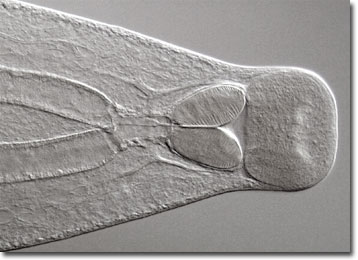Differential Interference Contrast Image Gallery
Chinese Liver Fluke (Clonorchis sinensis)
Clonorchis sinensis is commonly referred to as the Chinese liver fluke because of its predominance in that country. The parasitic flatworms are also frequently found in Korea, Vietnam, and Japan, where they primarily target humans as their definitive hosts, though several other animals are also disposed to infection.

Similar to many other parasites, Chinese liver flukes have a three-host lifecycle and must, therefore, reside in two intermediate hosts before infecting a definitive host. The first hosts of the species are snails, which ingest the eggs of the flukes from contaminated water. The eggs complete their gestation in the snails before hatching and exiting the organisms. The trematodes then burrow into fish, their second intermediate hosts, where they become encysted inside muscle tissue. Humans, or other animals, become the final hosts of the flukes when they eat the raw flesh of an infected fish.
In their definitive host, Chinese liver flukes inhabit bile ducts of the liver and may grow up to one inch in length. The parasites achieve full maturity only 3 to 4 weeks after they reach their final destination, but may live for as long as 25 years. Small numbers of the flukes may exist asymptomatically in humans and other animals, but large infestations are frequently accompanied with abdominal pain, digestive problems, jaundice, fibrosis, and enlargement of the liver. Known as clonorchiasis, chronic liver fluke infestation is rarely fatal, but can lead to increased susceptibility to dangerous bacteria such as Salmonella.
